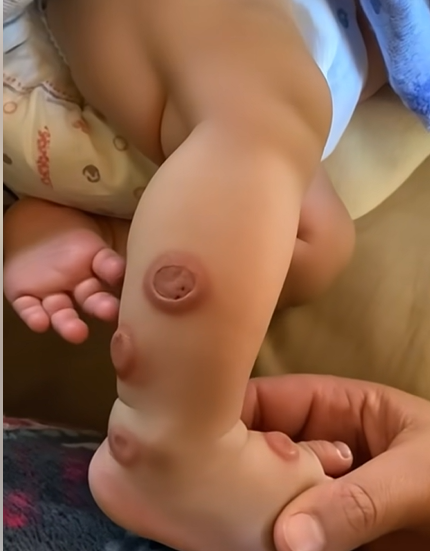In the world of primary care, healthcare providers often face the challenge of diagnosing symptoms that could point to a wide array of conditions—from the very common to the exceptionally rare. One such case involved a 55-year-old woman who developed an unexpected dermatological reaction following a change in her treatment regimen for a chronic respiratory condition.
The patient had a medical history of high blood pressure and chronic obstructive pulmonary disease (COPD). She had been receiving regular treatment for several years, which included an ACE inhibitor for blood pressure and a long-acting bronchodilator for her respiratory symptoms. Recently, due to a worsening of her pulmonary condition, her pulmonologist made an adjustment to her therapy—discontinuing one inhaler and initiating a new combination medication designed to provide broader bronchodilation support.
Just two days after beginning the new inhaled medication, the patient reported the sudden appearance of red, painful skin patches on her face and neck. These areas were inflamed and tender to the touch, and she also developed a low-grade fever. She had not introduced any new skincare products, made no dietary changes, and had only limited sun exposure while using proper sun protection. Importantly, there were no symptoms suggestive of a viral infection, and she had not experienced any respiratory or cold-like symptoms in the days leading up to the onset of the rash.
Recognizing the severity and unusual nature of the skin reaction, her primary care physician decided to refer her for urgent dermatological evaluation. A thorough assessment was performed, during which the new medication was discontinued, and additional diagnostic procedures were initiated. These included a skin biopsy and a series of blood tests to evaluate immune markers and potential underlying conditions.
While awaiting the results, the patient began a course of oral corticosteroids. Within 48 hours of starting treatment, her symptoms began to subside. The redness and swelling of the lesions decreased, and the discomfort improved significantly. Blood test results showed an increased white blood cell count—particularly neutrophils—along with other immune indicators. The biopsy results, which arrived about three weeks later, confirmed the diagnosis: Sweet syndrome.
Sweet syndrome, medically referred to as acute febrile neutrophilic dermatosis, is a rare inflammatory skin condition. It typically presents with the sudden appearance of red or purple skin lesions, most often on the face, neck, arms, and upper trunk. These lesions are usually painful and may be accompanied by systemic symptoms such as fever, fatigue, and elevated inflammatory markers in the blood.
Histologically, the condition is marked by a dense infiltration of neutrophils—one type of white blood cell—in the skin’s dermal layers, but without signs of blood vessel inflammation. While the cause is not always clear, Sweet syndrome can occur in response to infections, autoimmune disorders, cancer, or certain medications. In some cases, no clear trigger is ever identified.
Possible Triggers and Underlying Causes
In this particular case, the condition was likely induced by the recent introduction of a new inhaled medication. While many drug-induced forms of Sweet syndrome have been documented—particularly related to antibiotics, antiepileptics, blood pressure medications, and even vaccines—there had been no previous reports of the syndrome being triggered by the specific combination of medications prescribed in this case. That made the case noteworthy in terms of clinical observation.
Drug-induced Sweet syndrome is more commonly reported in women and is typically reversible upon discontinuation of the triggering agent. However, the condition can also serve as a sign of deeper systemic health issues, including autoimmune diseases like lupus, inflammatory bowel disease, or even certain types of cancer, especially blood-related malignancies. That’s why proper investigation is essential following the initial diagnosis.
Diagnosis and Clinical Criteria
Diagnosing Sweet syndrome relies on a combination of clinical presentation, laboratory findings, and histopathological confirmation. The most accepted diagnostic framework includes both major and minor criteria.
Major Criteria:
- Sudden onset of painful, red or purplish skin lesions
- Skin biopsy showing a dense infiltration of neutrophils without vasculitis
Minor Criteria:
- Fever or history of recent infection
- Elevated white blood cell count (leukocytosis)
- Presence of systemic symptoms like joint pain or eye inflammation
- Rapid improvement after starting corticosteroids
In this case, the patient met both major criteria and several minor criteria, leading to a confident diagnosis.
Treatment and Outcome
The first-line treatment for Sweet syndrome is systemic corticosteroids, which often result in rapid symptom resolution. In most cases, significant relief is seen within a few days, and the skin lesions typically fade within a week or two. Alternative treatments may include non-steroidal anti-inflammatory drugs, immunosuppressive therapies, or topical agents in milder cases.
Following the discontinuation of the new medication and the corticosteroid course, the patient made a full recovery. The lesions disappeared, and no further complications were reported. Nonetheless, she continued to be monitored to ensure there were no signs of an underlying systemic condition.
Why This Case Matters in Primary Care
Though Sweet syndrome is rare, it is a critical differential diagnosis that primary care providers should be aware of—especially when skin reactions are sudden, painful, and accompanied by systemic symptoms. This case underscores the importance of early recognition, prompt referral, and thorough investigation of unusual skin presentations, particularly when they follow changes in medication.
It also highlights the importance of keeping an open mind to less common diagnoses. While many skin reactions are benign and self-limiting, others—like Sweet syndrome—can serve as a warning sign for more serious underlying diseases. Physicians in a primary care setting are often the first point of contact for such cases, and their clinical suspicion plays a vital role in initiating timely care.
Final Thoughts
Sweet syndrome is a complex but treatable dermatological condition that requires attention to both skin symptoms and potential systemic implications. Although its exact cause is not always identifiable, understanding its associations with infections, medications, autoimmune conditions, and malignancies is crucial for accurate diagnosis and effective management.
In this case, the early action by the primary care physician and the collaboration with specialists led to a positive outcome and added valuable knowledge to the limited reports of drug-induced Sweet syndrome. It also serves as a reminder that even routine medication changes can occasionally have unexpected effects—something every clinician should be prepared to recognize.



